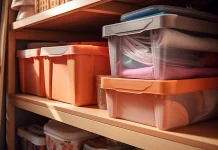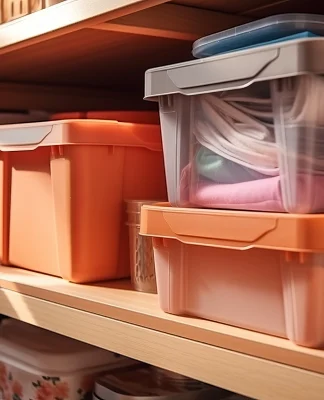 Art is one of life’s greatest pleasures. It helps us decorate our homes, unleashes a myriad of emotions, and is a hobby that unites many people. Because of this, it’s not uncommon for households to accumulate a collection of art over the years. Whether your collection is expensive or simply irreplaceable, you’ll want to take the proper precautions to keep them safe. For whatever reason, if you need to put things into storage, it’s important to understand the ins and outs of storing paintings. In this article, we’ll go over everything you need to know about how to store paintings like an expert.
Art is one of life’s greatest pleasures. It helps us decorate our homes, unleashes a myriad of emotions, and is a hobby that unites many people. Because of this, it’s not uncommon for households to accumulate a collection of art over the years. Whether your collection is expensive or simply irreplaceable, you’ll want to take the proper precautions to keep them safe. For whatever reason, if you need to put things into storage, it’s important to understand the ins and outs of storing paintings. In this article, we’ll go over everything you need to know about how to store paintings like an expert.
Know Your Risks
Before you start wondering about how you’re going to store your paintings, you need to be aware of the risks that are associated with doing so. If the painting is rare, expensive, or one-of-a-kind, you might want to consider talking to a professional painting storage expert. Doing so will reduce the chances that damage is incurred and will help elongate the life of your painting. This doesn’t mean that you’ll need to store your painting in an expensive warehouse, but the preliminary packing and preparations are important and might be specific to your art’s medium.
 With that being said, some of the most common risks to storing paintings include tears, breakages, fingerprints, stains, and environmental damage. Your painting could also be subject to having elements come loose, pests, or the damages of fluctuating climates if not stored properly. This isn’t a comprehensive list, but should be considered as an introduction to the risks of storing a painting. To reduce these things from happening, you need to adhere to the following suggestions for packing, preparing, and storing your paintings.
With that being said, some of the most common risks to storing paintings include tears, breakages, fingerprints, stains, and environmental damage. Your painting could also be subject to having elements come loose, pests, or the damages of fluctuating climates if not stored properly. This isn’t a comprehensive list, but should be considered as an introduction to the risks of storing a painting. To reduce these things from happening, you need to adhere to the following suggestions for packing, preparing, and storing your paintings.
Pack and Prepare
As we mentioned, the packing and preparations are going to be the biggest way to deter damages from happening during storage. Most of the risks of storing your paintings come from a combination of people, accidents, and poor storage conditions. To reduce your risks, take the following precautions.
1. Reduce Overall Outside Contact
The more people that touch or handle your painting while moving it into storage, the more chances there are for something to go wrong. Try to minimize overall outside contact and do the packing and preparations yourself. While it’s a great idea to contact a professional, there might not be one located in your city so you’ll have to take control of their recommendations. When moving the painting, consider transporting it in your car or hiring a moving van to take care of it yourself. While most movers handle your things with care, certain paintings aren’t worth the risk of accidental damage.
With that being said, minimize your own physical contact with the painting until it’s protected. The dirt, oil, and acidity from our fingertips can ruin a painting and should be avoided at all costs.
2. Protect the Painting
The first thing you’ll need to do when storing paintings is to protect it. Start by cleaning the painting with a microfiber cloth to ensure that all of the dust is cleared from the surfaces before putting it into storage. If you’re storing your painting in a frame, use the appropriate polish to make sure that rusting doesn’t occur. If the piece is expensive, consider getting it professional cleaned to make sure that everything is in the best condition possible for storage.
Next, you’ll need to wrap your painting. While many people think that  plastic will work for this step, you need to avoid using it. Even if you wrap your painting with 100% precision using cardboard and Styrofoam, plastic gives humidity a chance to fester, which can lead to mold. It’s simply not worth the risk. Instead, seal your painting with an acid-free Styrofoam or crescent board. This gives your painting the chance to breathe and stay protected during transit and storage. If you’re planning to use anything else to help store your painting, make sure that it is acid-free to avoid premature aging and damage from dye transfers.
plastic will work for this step, you need to avoid using it. Even if you wrap your painting with 100% precision using cardboard and Styrofoam, plastic gives humidity a chance to fester, which can lead to mold. It’s simply not worth the risk. Instead, seal your painting with an acid-free Styrofoam or crescent board. This gives your painting the chance to breathe and stay protected during transit and storage. If you’re planning to use anything else to help store your painting, make sure that it is acid-free to avoid premature aging and damage from dye transfers.
If possible, consider putting your wrapped painting into a wooden box for optimal protection. This will create a safeguard during transit and while in your storage space so that if something falls, it won’t damage the painting.
3. Choosing Your Storage Options
For most people, a simple self storage unit will suffice for storing paintings. Renting out an affordable, monthly unit is much better than putting your beloved paintings into a basement or attic, as the conditions are usually more controlled. Therefore, if you do choose to rent out a self storage unit, make sure that you find one that is climate controlled, not just temperature controlled. Climate controlled storage allows you to achieve the perfect conditions for storing a painting. Climate controlled storage units reduce direct sunlight, keeps temperatures constant, and regulates humidity levels 24 hours a day, 7 days a week.
 The absolute best temperature to store paintings in is about 70 to 75 degrees Fahrenheit with a humidity level at about 40-50%. Rapid changes in both temperature and humidity are detrimental to the longevity of your painting, so a climate controlled environment is highly recommended and well worth the investment. The Lock Up Self Storage offers climate controlled self storage units in a range of sizes for all budgets.
The absolute best temperature to store paintings in is about 70 to 75 degrees Fahrenheit with a humidity level at about 40-50%. Rapid changes in both temperature and humidity are detrimental to the longevity of your painting, so a climate controlled environment is highly recommended and well worth the investment. The Lock Up Self Storage offers climate controlled self storage units in a range of sizes for all budgets.
4. Putting Your Painting in Storage
Now it’s time to put your painting into your climate controlled self storage unit. Here are some simple steps to follow to ensure that your painting stays in great condition for years to come.
- Don’t Stack Paintings – if you’re storing more than one painting, do not stack them on top of each other. If you stack paintings on top of each other, over time the weight will cause warping, breakage, and permanent damage to the canvas itself. Avoid stacking your paintings at all costs. If you can’t guarantee that this won’t happen, then invest in a proper painting rack or keep them in the crates. As long as there is no risk to something falling on top of your painting and damaging it, you can opt to store them flat. However, most professionals agree that vertical storage is the best way to preserve art as it mimics the way art is supposed to hang on the wall.
- Avoid Direct Sunlight or Heat – direct sunlight and heat sources will ruin the painting. Over time, the colors in your artwork will fade and depending on the materials, your painting can eventually melt. Simply put, direct sunlight and heat should be avoided at all costs. Keep them at a steady temperature in a climate controlled self storage unit to avoid damages.
- Never Store Artwork on the Floor – never, ever store your artwork on the floor. The floor can be a source of pests, water, and dust. Instead, make sure that you use something to keep all of your artwork of the ground, even when using a climate controlled space. If possible, consider hanging your art in your self storage unit. Professionals recommend using chain link fences and S hooks to keep all of your artwork hung up, even when not in sight.1 If that’s out of the question, invest in a few pallets and store your paintings like they would be placed in a bookshelf.
- Properly Document Your Painting – if your painting is worth a lot of money, you need to properly document and archive it before putting it into storage—especially if you’re storing more than one. This will ensure that your assets are protected over time. While this step isn’t as important when using a self storage unit, since you’ll be in full control of storage, it’s still a good idea. If you want to go above and beyond in protecting your painting’s value, consider getting insurance for your collection.
If you’re looking for a place to store all of your paintings and any other  extra items, look no further than The Lock Up Self Storage. All of our units are climate controlled, which means you’ll have the perfect year-round temperatures and humidity control to keep paintings in pristine condition. Our self storage units are also protected by state-of-the-art security measures, so you can rest easy knowing your art is in good hands. Our security system includes 24/7 video monitoring, individually coded access gates, a full perimeter alarm, and motion-sensor lighting systems. Regardless of your storage needs, you’ll be able to find something at The Lock Up. We have a variety of sizes of self storage units and flexible leases so you can upgrade to a larger space when your needs change. If you’re looking for a self storage unit, The Lock Up Self Storage is here to help. Give us a call at 1-866-327-LOCK today to inquire about our available units in your area or stop by any of our locations to speak with a representative.
extra items, look no further than The Lock Up Self Storage. All of our units are climate controlled, which means you’ll have the perfect year-round temperatures and humidity control to keep paintings in pristine condition. Our self storage units are also protected by state-of-the-art security measures, so you can rest easy knowing your art is in good hands. Our security system includes 24/7 video monitoring, individually coded access gates, a full perimeter alarm, and motion-sensor lighting systems. Regardless of your storage needs, you’ll be able to find something at The Lock Up. We have a variety of sizes of self storage units and flexible leases so you can upgrade to a larger space when your needs change. If you’re looking for a self storage unit, The Lock Up Self Storage is here to help. Give us a call at 1-866-327-LOCK today to inquire about our available units in your area or stop by any of our locations to speak with a representative.
For most people, a simple self storage unit will suffice for storing paintings. Renting out an affordable, monthly unit is much better than putting your beloved paintings into a basement or attic, as the conditions are usually more controlled. Therefore, if you do choose to rent out a self storage unit, make sure that you find one that is climate controlled, not just temperature controlled. Climate controlled storage allows you to achieve the perfect conditions for storing a painting. Climate controlled storage units reduce direct sunlight, keeps temperatures constant, and regulates humidity levels 24 hours a day, 7 days a week.



















